Close cousins
Chimps and bonobos are humans’ nearest living relatives
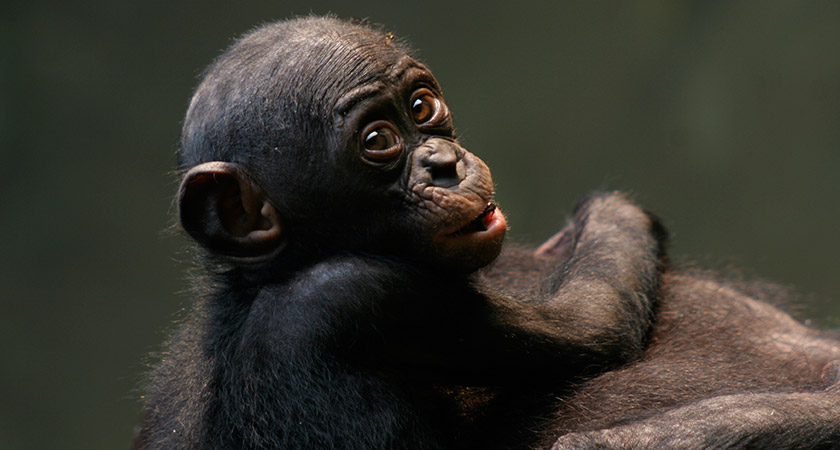
Bonobos are apes that are closely related to chimpanzees and humans. This photo was taken at Lola ya Bonobo, an orphanage for baby bonobos in the Democratic Republic of the Congo.
Friends of Bonobos
By Roberta Kwok
In 2007, Victoria Wobber visited a wildlife sanctuary in central Africa. Called Lola ya Bonobo, this sanctuary in the Democratic Republic of the Congo housed about 60 bonobos. The long-limbed apes resemble chimpanzees, to which they are closely related.
But studies show bonobos are not somewhat tiny chimps. The two species have strikingly different personalities.
Bonobos, for instance, spend a lot more time playing games. Wobber watched some “breakdance” — spinning on their backs atop the wet, leafy ground. Others covered their eyes with their hands to “blindfold” themselves, then ran around and crashed into trees.
“Bonobos do the silliest things,” says Wobber, a psychologist at Harvard University in Cambridge, Mass. Watching them, “It’s hilarious.”
Chimpanzees have a much more dangerous reputation. They can be quite violent, especially toward chimps they don’t know. Bonobos, on the other hand, generally maintain peace. They love to play and show affection.
These two species are our closest living relatives. About six million years ago, an ape species split into two groups. The first group evolved, or changed over a long period of time, into humans. The second group split into chimpanzees and bonobos about one million years ago.
Scientists are studying similarities and contrasts between these cousin species. For example, researchers have investigated how the apes develop into adults, treat strangers and use gestures to communicate. The findings are helping reveal how our ancestors evolved — and what makes humans unique.
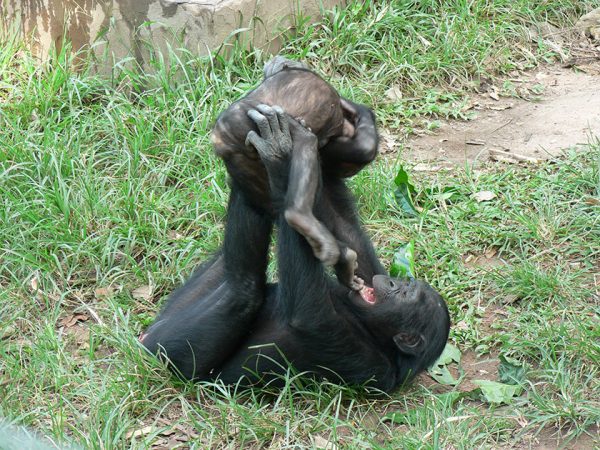
War and peace
Chimps and bonobos share many features. Both have black hair and can grow to weigh more than 45 kilograms (100 pounds). Unlike monkeys — but like people — they lack tails. Both chimps and bonobos live mainly in rainforests and love to eat fruit, especially figs. They also dine on leaves, twigs, seeds and a little meat.
Bonobos tend to be slightly more slender. Their faces are usually black, while chimps’ faces can be black or tan. Wild bonobos live only in the Democratic Republic of the Congo, south of the Congo River. Chimpanzees live all along the equator in Africa.
But the biggest differences lie in their behaviors. Among chimps, males dominate. The animals often slap, kick and bite one another. If they meet members of another group, they fight and sometimes kill the strangers. Just like humans, chimps wage wars. They “parallel the darker aspects of our nature,” says Wobber.
Among bonobos, females usually lead. While they also fight, they usually do so to beat up bullies. For example, two females will attack a male that is threatening other bonobos. And when two groups of bonobos meet, they rarely fight. In fact, they sometimes hang out, play and groom each other. “You’d think they’re friends, but they actually just met,” says Jingzhi Tan of Duke University in Durham, N.C. An anthropologist, Tan is a scientist who studies human nature.
Chimps and bonobos may have evolved differently because of their environments. Chimpanzees share their habitat with gorillas, with whom they have to compete for food. Ancestors of the bonobos probably got stranded south of the Congo River. It’s a region free of gorillas. Because bonobos didn’t have to worry as much about food, says Wobber, they could afford to cooperate more and fight less. Eventually, bonobos became peaceful and happy-go-lucky.
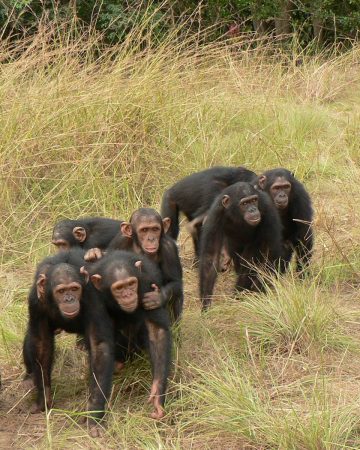
Not growing up
Wobber wanted to investigate whether the differences in chimp and bonobo behavior emerged during development, the process of growing up. For example, adult bonobos share their food more than adult chimps do. Wobber wondered if this pattern held true among young bonobos and chimps as well.
So in 2007, her team tested some behaviors of young bonobos and chimps. The researchers placed bananas in a room. Then the team let two young chimps into the room and observed whether they shared. The researchers performed the same test using apples — bonobos’ preferred food — with pairs of bonobos.
These young animals often shared food, Wobber found. But when the team repeated the experiments with adults, the results changed — for chimps. Adult bonobos kept sharing; adult chimps didn’t. Indeed, a bullying chimp typically hogged all of the bananas.
The study suggested that adult chimps “outgrew” their tendency to share. Even though the weaker chimp probably wanted bananas too, it suppressed its desire to lunge at the fruit. This chimp probably refrained from eating because it feared being attacked by the stronger animal.
Both young and adult bonobos readily share their food. But chimpanzees stop sharing food when they grow older.
Perhaps as part of growing up, adult chimps develop more self-control, Wobber thought. In other words, the animals learn to hold back instead of trying to grab the food.
To test that, her team set up another experiment. Three people faced a young chimp or bonobo. The animal saw the two outer people pick up food, while the middle person did nothing. The chimp or bonobo could ask for food by touching the person’s hand. If the animal had developed self-control, it should avoid begging the middle person for food.
By age 3, most chimps requested food only from the two outer people. But bonobos of the same age kept asking the middle person for food too. They took a lot longer than chimps to learn this type of self-control.
The results might mean that bonobos keep sharing because they don’t grow up as quickly. “Bonobos don’t really change,” concludes Wobber.
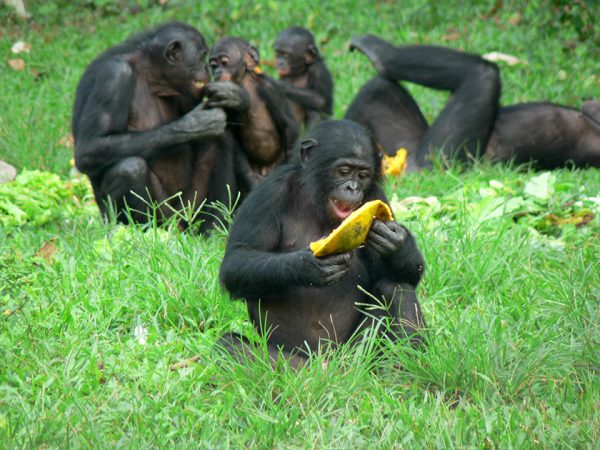
Perhaps as part of growing up, adult chimps develop more self-control, Wobber thought. In other words, the animals learn to hold back instead of trying to grab the food.
To test that, her team set up another experiment. Three people faced a young chimp or bonobo. The animal saw the two outer people pick up food, while the middle person did nothing. The chimp or bonobo could ask for food by touching the person’s hand. If the animal had developed self-control, it should avoid begging the middle person for food.
By age 3, most chimps requested food only from the two outer people. But bonobos of the same age kept asking the middle person for food too. They took a lot longer than chimps to learn this type of self-control.
The results might mean that bonobos keep sharing because they don’t grow up as quickly. “Bonobos don’t really change,” concludes Wobber.
Kind to strangers
Tan, the scientist at Duke University, studies apes to learn what makes humans unique. If people possess a certain behavior that chimps and bonobos don’t, that feature sets us apart from our closest relatives.
For example, some researchers thought humans were the only animals to show generosity toward strangers. People often hold open a door for others. Many also donate blood or body organs to patients they’ll never meet.
But what about bonobos? Scientists already knew that bonobos like playing with strangers. Maybe they also granted strangers favors, just as people do.
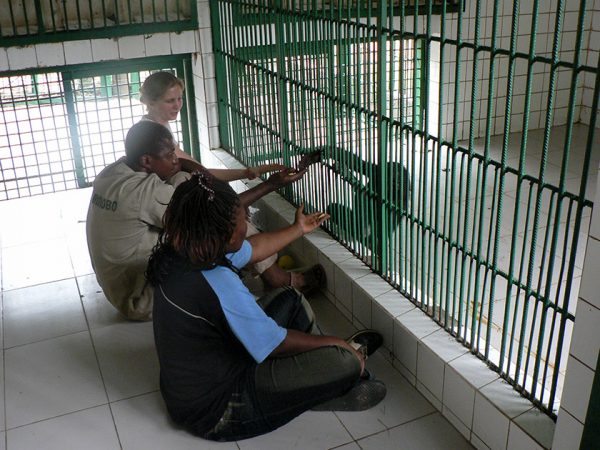
To find out, Tan’s team ran experiments with young and adult bonobos from 2009 to 2011. First, they put a bonobo in a room with a delicious salad of bananas, apples, papayas and peanuts. This room was connected to two others. One of those other rooms held a bonobo that the first bonobo already knew. The third room held a strange bonobo that the first animals had never met.
The first bonobo could see the other animals through mesh walls. But the door to each room was “locked” with a wooden peg. To let in another animal and share the food, the first bonobo had to deliberately remove the peg.
Most times, the bonobo with the food unlocked at least one door. But surprisingly, the animal often opened the stranger’s door first. The bonobo preferred to share its food with an unknown animal.
Tan wondered why. Perhaps the animal wanted to make a new friend, and playing with the strange bonobo became its reward for sharing. Or maybe the bonobo was just generous.
To investigate, the researchers set up a more complex trial. This time, a bonobo could pull a long rope to let a strange bonobo into a tunnel with food. Another mesh wall separated the first bonobo’s room from that tunnel.
The first bonobo couldn’t reach the food through the mesh, so it wasn’t giving anything up by doing the stranger a favor. The mesh wall also prevented the bonobos from playing with each other, even if the stranger entered the tunnel.
Still, most bonobos let the stranger enter the tunnel to get at the food. That suggested bonobos were simply generous. They helped strangers obtain a meal, even though the donor received no direct benefit.
Then Tan’s team changed the set-up. This time, the food in the tunnel was placed closer to the first bonobo. That animal could now reach the food through the mesh wall. Letting the stranger into the tunnel would mean giving up food — but still without the reward of playing with a new friend.
Under these conditions, no bonobo pulled the rope. “They stopped sharing,” says Tan. “They just ate every single piece of food.”
The study shows that bonobos are unselfish, but only up to a point. If they have to give something up and don’t get anything in return — such as a new friend — they won’t share. Tan plans to test whether people respond to these types of situations in the same way.
Learning to “talk”
Other researchers study chimps and bonobos to investigate how language has evolved. Some of these apes have learned to communicate using sign language. Others learn to point to lexigrams, or symbols that represent specific words.
Children also learn language as they grow up. Many will gesture before they can speak. For example, a child might point at water when she wants a drink, even if she can’t say the word “water”.
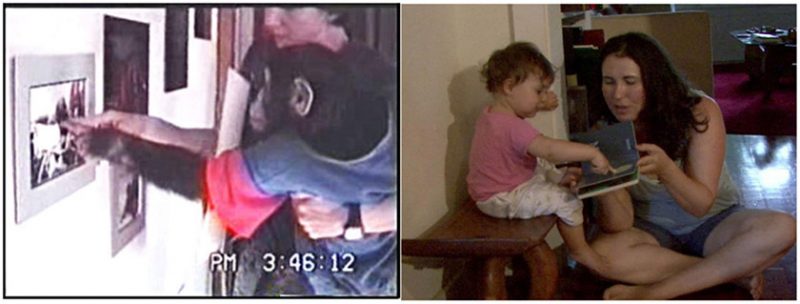
That behavior fascinated Kristen Gillespie-Lynch, a psychologist who now works at the College of Staten Island in New York City. She wondered whether chimps and bonobos also gestured as a stepping-stone to learning words. If they did, perhaps this behavior was present in the common ancestor of humans, chimps and bonobos.
From 2009 to 2012, Gillespie-Lynch’s team analyzed old videos of a young chimp and bonobo taken in the 1980s. Both animals lived at a research center in Atlanta, Ga. People trained the young apes to communicate with lexigrams. For example, the animal might point at a symbol for “blueberry” to express a desire to eat blueberries. Or the animal could point at a symbol for “monster” to ask a person to put on a scary mask for fun.
Gillespie-Lynch’s team also videotaped an 11- to 18-month-old child as this girl learned to speak. Then the team compared the behaviors they had witnessed in all three species.
The young girl, chimp and bonobo used similar gestures, the scientists found. For example, they often pointed at or reached for objects. They raised their arms to ask to be picked up. And they frequently looked at a caregiver or repeated their gestures to further encourage that person to respond.
The girl mainly used gestures to communicate before learning to say words. The chimp and bonobo also depended mostly on gestures before learning to point to lexigrams.That might mean the common ancestor of humans, bonobos and chimps communicated with gestures before evolving the capacity to use symbols such as words or lexigrams.
Scientists can’t figure out how language evolved by digging up the remains of ancient apes. “Language doesn’t have a fossil record,” explains Gillespie-Lynch. Instead, researchers study the three species living today in hopes of reconstructing history.
Adding to the challenge of these studies: Both chimps and bonobos are endangered. People hunt the apes as food and chop down the forests they live in to make way for farms and cities. So researchers have to hurry to study the animals while they still can. “We don’t know how many years they have left,” says Tan.
Recently, chimpanzees got a boost. On June 12, 2013, the U.S. Fish & Wildlife Service proposed listing all chimps — even those in captivity — as endangered with extinction. If the new rule is adopted into law, it would restrict the ability of U.S. medical researchers to use chimps in tests that might harm the animals. (Similar limits already exist for research with bonobos.)
The research by Wobber, Tan and Gillespie-Lynch won’t directly save the two species. But they are learning more about the animals, and many of their studies show how closely they resemble humans. The work might convince people that it’s important to protect these animals. Argues Tan, “You cannot save the bonobos without people knowing what bonobos are.”
Power Words
anthropologist A researcher who studies humans, their behavior and their culture.
bonobo An endangered ape species that is closely related to chimpanzees and humans. Bonobos have black hair and black faces. In the wild, they live only in the Democratic Republic of the Congo in Africa, south of the Congo River.
chimpanzee An endangered ape species that is closely related to bonobos and humans. Chimpanzees have black hair, and black or tan faces. They live along the equator in Africa.
development The process of growing up.
evolve To change over a long period of time. Species that evolve usually undergo some genetic changes that help them better adapt to their environment.
lexigram A symbol that represents a word.
psychologist A researcher who studies mental processes and behavior.
species A group of organisms consisting of similar individuals







